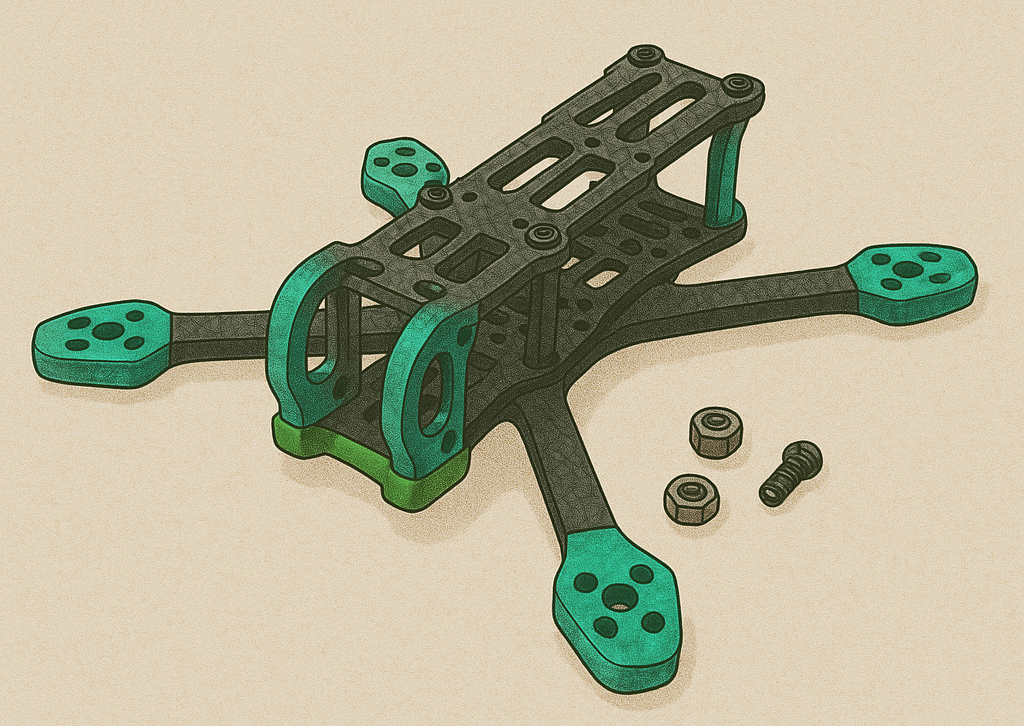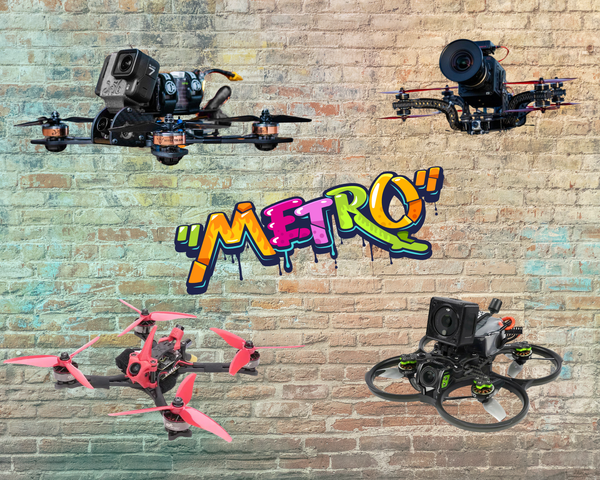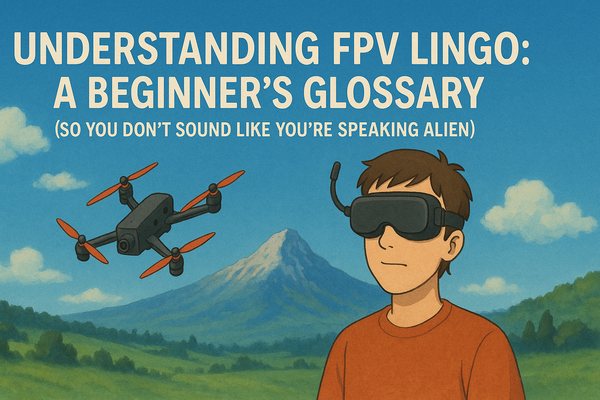Finding Your Drone's Bones: A Beginner's Guide to FPV Frames


So, you're ready to strap on those goggles and experience the world from a bird's-eye view? Excellent choice! But before you can truly unleash your inner pilot, you need a solid foundation for your flying machine – the FPV frame.
Think of the frame as far more than just a collection of carbon fiber plates and standoffs. It's the very architecture of your drone, influencing everything from its resilience in a tumble to its agility in the air and even the clarity of your onboard camera footage. Choosing the right frame as a beginner can feel overwhelming, like navigating a hardware store written in a foreign language. But fret not, aspiring aviator! This expanded guide will dissect the essential aspects of FPV frames, arming you with the knowledge to select the perfect "bones" for your aerial journey.
The Underrated Importance of Your Drone's Skeleton:
The frame is the unsung hero of your FPV rig. Its impact stretches far beyond simply holding components together:
- Crash Survivability: Your First Line of Defense: Let's be honest, gravity has a magnetic pull on new FPV pilots. A well-designed frame, constructed from durable materials like high-quality carbon fiber of sufficient thickness (often 4mm or 5mm for arms on 5-inch frames), can absorb the impact of those inevitable "learning experiences," protecting your more delicate (and expensive) electronics. Look for frames with robust arm designs and strategically placed standoffs that can help dissipate force.
- Weight Management: The Balancing Act: In the world of FPV, every gram counts. A lighter frame can translate to longer flight times due to reduced power consumption and snappier handling. However, shedding too much weight can compromise structural integrity. The ideal frame strikes a balance between being lightweight enough for good performance and sturdy enough to survive a less-than-perfect landing (or tree encounter).
- Size and Agility: Finding Your Maneuvering Sweet Spot: The size of your frame, often measured by the motor-to-motor (M2M) diagonal distance, dictates the maximum propeller size you can use. Smaller frames (like 2.5-inch to 4-inch "micros" or "minis") tend to be more agile and are great for tight spaces, while the popular 5-inch frames offer a good balance of power and maneuverability for both freestyle and general flying. Larger frames (6-inch and up) can carry heavier payloads, like larger batteries or more sophisticated camera equipment, but might feel less nimble.
- Component Harmony: A Well-Organized Interior: A thoughtfully designed frame will feature strategically placed mounting holes and ample internal space for your flight controller stack (FC and ESCs), receiver, VTX, and other components. This not only makes the building process cleaner and easier but also helps with cable management and airflow, which is crucial for keeping your electronics cool. Some frames even offer specific mounting solutions for popular HD cameras like GoPros or DJI O3 units.
- The Unwanted Guest: Propeller Intrusion in Your FPV Feed: Have you ever watched an FPV video with annoying propeller blades constantly dipping into the view? The frame's design, particularly the length and angle of the arms, plays a significant role in keeping those props out of your camera's field of vision, providing a cleaner and more immersive flying experience. This is a key consideration, especially if you plan on capturing onboard footage.
Exploring the Family of FPV Frames:
As you delve deeper, you'll discover a diverse ecosystem of frame designs. Here's a more nuanced look at some common types for beginners:
- The Versatile X-Type: Symmetry for StabilityImagine a perfectly balanced "X" when viewing your drone from above, with each motor arm extending equidistantly from the center. This symmetrical design contributes to predictable and balanced handling, particularly in yaw. It's a fantastic starting point for learning smooth flight and provides a solid platform for transitioning into more advanced maneuvers. Variations like the "Stretched X" (longer along the pitch axis) can offer improved forward flight stability, often favored for racing or smooth cruising, while "Squashed X" frames prioritize compactness and quick yaw response for more aggressive freestyle.
- The Roomy H-Type: Space and Prop ClearanceResembling the letter "H" from above, these frames feature a more elongated central section connecting the front and rear motor arms. This design often provides more internal volume for neatly stacking electronics and can sometimes accommodate larger propellers without them colliding. While generally stable, some pilots find the yaw feel slightly different compared to a true X-frame due to the weight distribution being less centered.
- The Cinematic DC (DeadCat): Banishing Propeller ShadowsThe "DeadCat" design, a clever offshoot of the X-frame, specifically addresses the issue of propellers obstructing your HD camera's view. By extending the front arms forward, the front props are pushed out of the frame, resulting in cleaner, more professional-looking aerial footage. While ideal for videography, beginners should be aware that the asymmetrical geometry can subtly alter the drone's yaw characteristics, potentially requiring a bit of getting used to in terms of handling. However, with proper tuning, this difference can often be minimized.
- The Less Common Plus (+): A Historical PerspectiveIn a Plus (+) configuration, the motor arms extend directly forward, backward, and to the sides. While historically significant, this design is less prevalent in modern FPV, particularly for racing and freestyle, as its yaw authority (the ability to rotate precisely around the vertical axis) is generally considered less direct and "locked-in" compared to X or H frames. You might encounter older BNF (Bind-and-Fly) drones with this configuration.
Key Considerations for Your First Frame:
- Material and Thickness: The Armor of Your Drone: Carbon fiber is the gold standard for FPV frames due to its exceptional strength-to-weight ratio. Pay attention to the thickness of the carbon fiber, especially for the arms, which are most susceptible to impact. 4mm or 5mm arms on a 5-inch frame offer a good balance of durability for beginners.
- Size Matters (M2M): Finding Your Prop Sweet Spot: The motor-to-motor (M2M) distance dictates the maximum propeller size your frame can accommodate. For beginners, 5-inch frames are a popular starting point, offering a good blend of power and maneuverability. Smaller frames (2-4 inch) are great for learning indoors or in confined outdoor spaces, while larger frames (6+ inch) are often chosen for longer flight times or carrying heavier payloads.
- Weight: The Efficiency Equation: While a lighter drone can be more efficient and feel more agile, prioritize durability as a beginner. Don't chase the absolute lightest frame if it means sacrificing significant strength.
- Build Friendliness: Making Assembly Less Painful: Look for frames with clear instructions (if available), ample space for routing wires, and well-placed mounting holes that align with standard component sizes (e.g., 20x20mm or 30.5x30.5mm mounting patterns for flight controllers and ESCs). Some beginner-focused frames even have simplified designs to make the initial build less daunting.
- Your Flying Aspirations: Choosing a Frame for Your Goals: Consider what you ultimately want to do with your drone. If you envision smooth, cinematic flights, a DC frame might be appealing. If agile acrobatics are your aim, an X-type is a solid choice. For general learning and exploration, a robust 5-inch X or H frame is often recommended.
The Takeaway for the Aspiring Pilot:
Choosing your first FPV frame is a crucial step in your journey. While the sheer variety can seem intimidating, understanding the basic types and the key considerations will empower you to make an informed decision. Don't be afraid to start with a well-regarded beginner-friendly frame and learn as you go. As your skills evolve and your flying style develops, you can always explore more specialized frame designs. The most important thing is to get a frame that's durable enough to survive your learning curve and allows you to experience the incredible thrill of FPV flight!




